Planet Earth II Blu-ray Movie 
BBC | 2016 | 300 min | Rated BBFC: 12 | Mar 28, 2017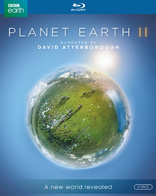
Movie rating
|
| 8.7 | / 10 |
Blu-ray rating
| Users | 0.0 | |
| Reviewer | 4.5 | |
| Overall | 4.5 |
Overview click to collapse contents
Planet Earth II (2016)
Planet Earth II is an immersive exploration of the jungles, mountains, deserts, islands, grasslands and cities of the world. Journey to the four corners of the globe to discover the extreme forces that shape life in each of these iconic landscapes and the remarkable ways animals manage to overcome the challenges of surviving in the wildest places on Earth.
Starring: David AttenboroughNarrator: David Attenborough
Director: Justin Anderson
| Documentary | Uncertain |
| Nature | Uncertain |
Specifications click to expand contents
Video
Video codec: MPEG-4 AVC
Video resolution: 1080p
Aspect ratio: 1.78:1
Original aspect ratio: 1.78:1
Audio
English: DTS-HD Master Audio 5.1 (48kHz, 16-bit)
Subtitles
English SDH
Discs
Blu-ray Disc
Two-disc set (2 BDs)
Packaging
Slipcover in original pressing
Playback
Region A (B, C untested)
Review click to expand contents
Rating summary
| Movie | 4.5 | |
| Video | 4.5 | |
| Audio | 5.0 | |
| Extras | 2.5 | |
| Overall | 4.5 |
Planet Earth II Blu-ray Movie Review
Nature, as Up Close and Personal as 1080p Will Allow
Reviewed by Michael Reuben April 2, 2017Ten years after the original Planet Earth, the BBC
premiered its sequel, Planet Earth II, with
U.K. broadcasts beginning on November 6, 2016. It took another three months for the series to
reach our shores, with U.S. broadcasts by BBC America, AMC and Sundance beginning on
February 18, 2017. By that point, the series was already available in Britain on Blu-ray and UHD.
BBC Home Video is now catching up with a U.S. Blu-ray release, but they have packaged the
discs differently for North American viewers. In the U.K., the UHD package followed the
familiar pattern of including both 1080p and 4K versions, but here the 4K release omits the
standard Blu-ray presentation. The standard Blu-rays are only available as a separate set, with
several differences in content discussed below.
The series remains the gold standard in nature documentaries, with its gently authoritative
narration by David Attenborough and vivid footage of landscapes and animals shot all over the
world. Filmed with a variety of cameras, many of them customized for the production's
specialized needs, Planet Earth II is billed as the first TV series specifically designed to be seen
in 4K and HDR, which means that the standard Blu-ray represent a downcoversion from the
source. It's a fine presentation, but it pales next to the quality of the UHD.
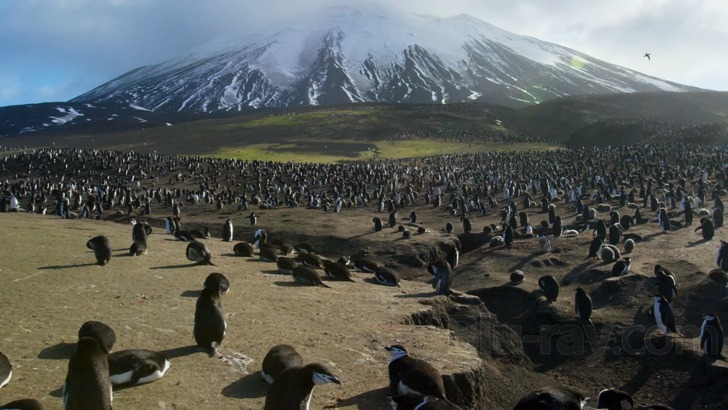
First of all, let me address an issue of which purchasers should be aware: The version of Planet Earth II presented on Blu-ray isn't identical to the program on UHD. In the Blu-ray version, eminent naturalist David Attenborough not only narrates but also appears on camera. At the beginning of Episode 1, he is seen in a hot air balloon floating above the Alps; at the end of the final episode, Episode 6, he speaks to the camera from the top of a skyscraper overlooking London. In the 4K version, however, Attenborough remains off-camera. His introductory remarks in Episode 1 are delivered as voiceover, but his concluding speech in Episode 6 (an extended plea for conservation) has been eliminated. Time discrepancies suggest that there may be other differences, but a shot-by-shot comparison is beyond the scope of this review. Also, since I did not see the recent broadcast, I cannot say whether the Blu-ray or the UHD more accurately represents the telecast.
Minor variations aside, Planet Earth II contains six episodes, each running around 52 minutes. The following descriptions are reproduced (with minor editing) from the BBC's official website for the series, which also provides detailed listings of each episode's locations and featured wildlife:
1. Islands
For some, remote islands offer sanctuary away from the mainland: the tiny pygmy three-toed sloth only survives because of the peace and safety offered by its Caribbean island home, while seabirds like albatross thrive in predator-free isolation. But island life isn't always easy. In the barren, volcanic islands of Galapagos, marine iguanas have been forced to find food in the ocean, but their ingenuity allows a raft of other animals to survive - including deadly racer snakes. At the end of the Earth, more than 1.5 million penguins appear to have found their version of paradise on an active, wave-battered volcano.
2. Mountains
Only a few pioneering animals have what it takes to survive up high in the world's great mountain ranges. Witness for the first time ever four snow leopards filmed together as a mother and cub become trapped in a desperate fight between two rival males. Like crazy pole dancers, Grizzly bears comically scratch their backs on trees whilst a bobcat struggles to hunt for ducks without getting its feet wet.
3. Jungles
From the jungles of Brazil, home to caiman-hunting jaguars and strange jungle dolphins that swim in the tree tops, to Costa Rica where ninja frogs fight huge wasps, we watch as the animals face life in the most competitive place on Earth. We follow alongside the beautiful indri as she bounces through the forest in Madagascar, and we stay out late at night to witness glow-in-the-dark creatures never before filmed.
4. Deserts
In this episode we visit the world's deserts, a land of extremes that pushes life to the limit. . . . A pride of desert lions are so hungry they risk hunting a giraffe several times their size, whilst male sand grouse fly nearly 200 kilometers each day from their nests to the nearest waterhole, simply to collect water for their chicks - and when they arrive there are predators waiting for them. And, never filmed before, a tiny bat takes on one of the world's deadliest scorpions just to get a meal.
5. Grasslands
Grasslands cover one quarter of all land and support the greatest gatherings of wildlife on Earth. The extraordinary creatures that live here must survive the most hostile seasons on the planet. From bizarre looking Saiga antelope in Asia, rarely seen by humans, to the giant ant-eaters of Brazil, grassland animals show remarkable survival techniques. In the flooded Okavango, lions take on formidable buffalo in epic battles, stunning bee-eaters ride on the back of ostriches like miniature jockeys, while caribou embark on great migrations, where they must cross paths with their nemesis, Arctic wolves.
6. Cities
Cities are growing at a faster rate than any other habitat on Earth. They may seem an unlikely place for animals to thrive, but for the bold this is a world of surprising opportunity. Leopards prowl the streets of Mumbai, peregrine falcons hunt amongst New York's skyscrapers and a million starlings perform spectacular aerial dances over Rome. We welcome some creatures into our cities; in Jodhpur langurs are revered as religious deities and in Harar locals live in harmony with wild hyenas.
Much of the footage is remarkable in its capture of rarely seen animal behavior. The editors have done a superb job of shaping the raw material to provide a narrative flow, and Attenborough's voiceover remains a lively and essential component of these tales from worlds rarely seen by the human eye.
Planet Earth II Blu-ray Movie, Video Quality 
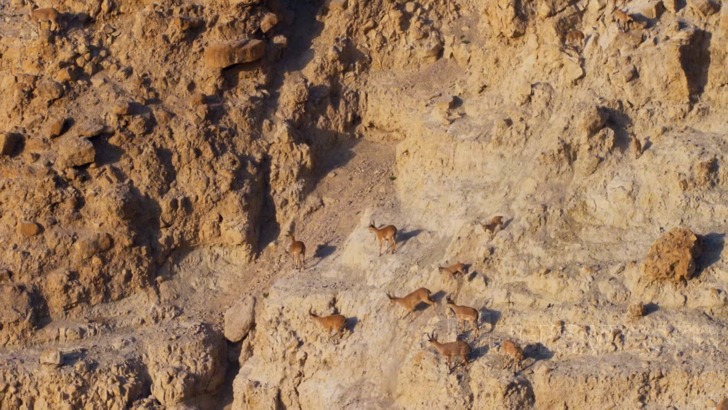
BBC Video has divided the six episodes of Planet Earth II evenly between two 1080p, AVC-encoded Blu-ray discs, which boast some
of the best imagery of which Blu-ray is capable.
Downconverted from the 4K master, the image still manages to reproduce the series' many
wildlife closeups with an intensity that is almost three-dimensional in its rendering of fine
textures and shadings of fur, feather and scale. The digital cameras bring these creatures much
closer to the viewer than one could ever hope to approach them (and, in many cases, survive the
encounter). Landscapes are also rendered with excellent fine detail, revealing minute variations
in ancient rock formations, dry desert sands, mountain peaks, flowing rivers and frozen
expanses—but here again, the 1080p version does its best in closeups.
It's in long shots, especially the prolonged aerial shots that are something of a trademark in BBC
Earth documentaries, that the limitations of 1080p begin to emerge. Without UHD's higher
resolution and HDR's enhanced contrast, the animals in these long shots sometimes fade into the
background, especially where the terrain and its inhabitants share similar coloration (see
screenshots 2 and 21 for examples). Even where contrasting colors enhance visibility, e.g., in
Episode 2's extended account of a family of Rocky Mountain grizzlies searching for food across
a snow-covered expanse (see screenshot 4), the creatures become noticeably less distinct at great
distance. A similar phenomenon affects the leaves and branches of dense foliage, which tend to
blur into a generalized mass of textured green and brown as the camera pulls away.
It should be stressed that none of these observations are a criticism of BBC Video's technical
presentation; rather, they are symptomatic of a video format operating at the boundaries of its
capabilities. The Blu-rays of Planet Earth still provide an excellent video rendition of the high-resolution source, and if one did not have the
UHD discs for comparison, the Blu-ray image
would no doubt rate the highest possible score for its vivid colors and impressive fine detail. But
1080p cannot fully convey the dazzling intensity of a source that was expressly designed to be
seen at a higher resolution with enhanced contrast and color. As good as they are, the Blu-rays of
Planet Earth II cannot escape being second-best.
Planet Earth II Blu-ray Movie, Audio Quality 
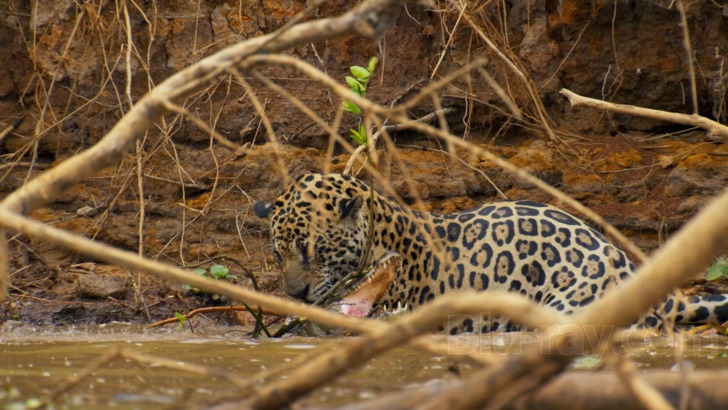
Planet Earth II arrives with a 5.1 surround mix encoded in lossless DTS-HD MA, and the sound editing is as sophisticated and precise as that of any feature film. The track doesn't attempt to replicate the disorganized racket of a natural environment. Instead, the mixers have selected specific sounds of nature to complement and accompany each scene, and those effects may be placed in front, in back or all around. Pans between left and right and between front and rear are frequent. Rain, surf, volcanic activity and the roar of an avalanche are among the many enveloping environmental effects. Countless varieties of animal vocalizations occur both on- and off-screen. All of these effects are seamlessly integrated with David Attenborough's narration, which floats authoritatively over the front center, and with the orchestral score by Jasha Klebbe and Jacob Shea (with the principal theme by Hans Zimmer), which has the sweep and grandeur of a major Hollywood adventure.
Planet Earth II Blu-ray Movie, Special Features and Extras 
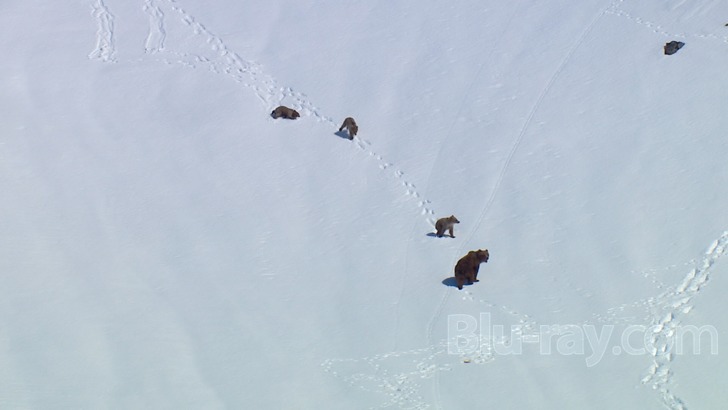
- Planet Earth II Diaries (1080p; 1.78:1): Each of the series' six episodes is followed by a making-of featurette between eight and nine minutes in length. The featurettes are narrated by Attenborough, and the music and sound effects are of similar high quality (and, like the main feature, encoded in DTS-HD MA 5.1). All of them display the familiar style of the Planet Earth series, and the major difference is the appearance on camera of producers, photographers and other crew, who are braving hardships, hazards and the vagaries of weather and terrain to capture a rare encounter or a vista that's never been seen before.
- Introductory Trailers: At startup, disc 1 plays trailers for The Hunt and Tauck's Earth Journeys nature tours, while disc 2 plays a trailer for London Road.
Planet Earth II Blu-ray Movie, Overall Score and Recommendation 

A recurrent theme throughout Planet Earth II is the degree to which many of the landscapes
captured by the project have been (and continue to be) changed by human expansion. From that
perspective, the decision to devote the final chapter to "Cities" is noteworthy, as it charts some of
the unexpected adaptations created by the narrowing space between civilization and nature. Who
would have expected that Earth's largest leopard population would be residents of Mumbai,
surviving on local livestock and the occasional passerby? The concluding visit to Singapore's
Avatar City (a/k/a "Garden by the Bay") provides a reassuring example of the possibility for
peaceful coexistence of people and wildlife, and it's an installation as exotic as any of the far-flung corners that Planet Earth II has already
visited. Planet Earth II is the most vivid
sightseeing you can undertake without leaving home, and even though the Blu-rays can't match
the visual intensity of the UHD discs, they're still a trip worth taking. Recommended.




















